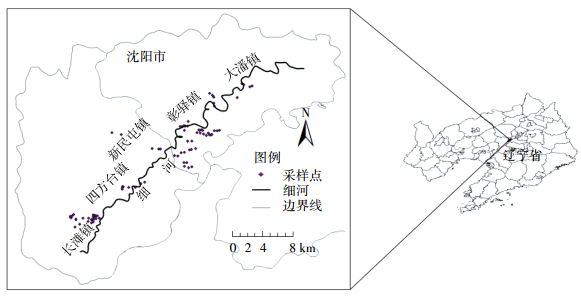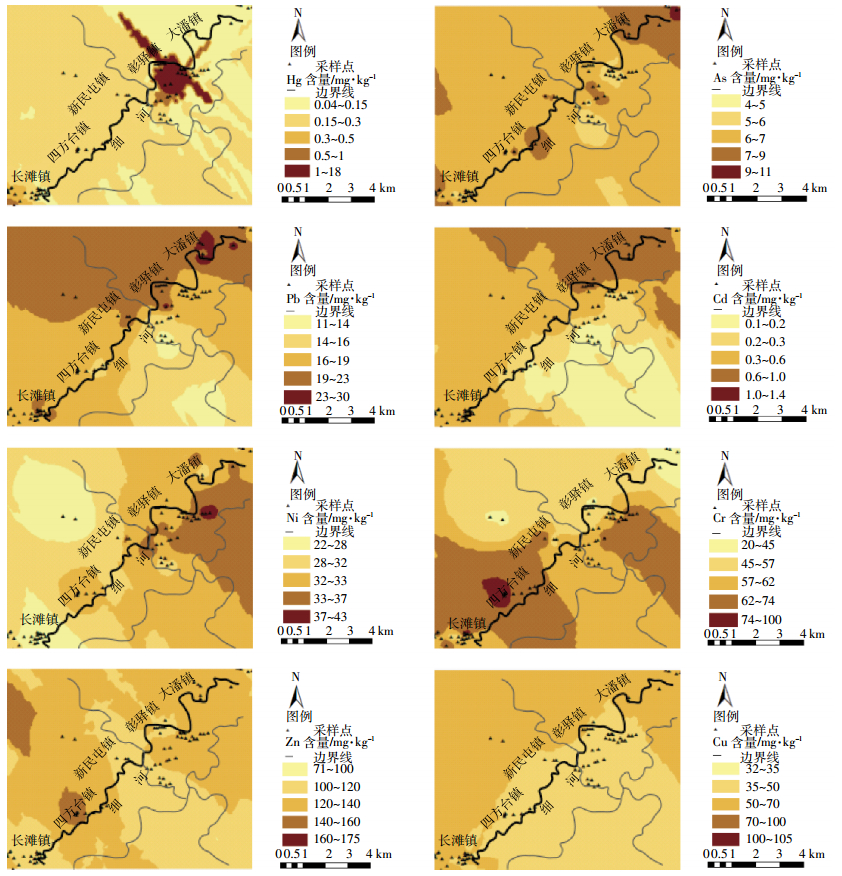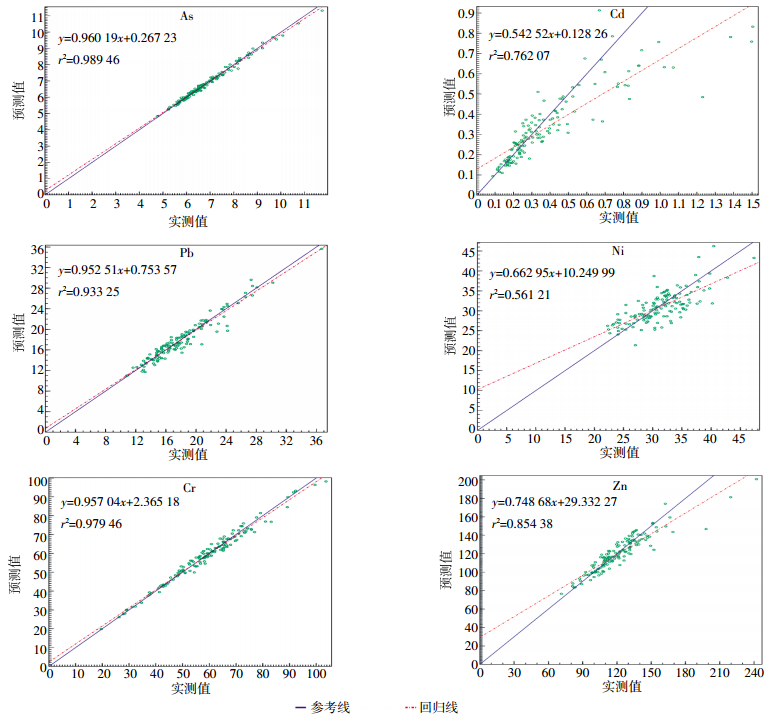文章信息
- 宁翠萍, 李国琛, 王颜红, 李波, 田莉, 王世成
- NING Cui-ping, LI Guo-chen, WANG Yan-hong, LI Bo, TIAN Li, WANG Shi-cheng
- 细河流域农田土壤重金属污染评价及来源解析
- Evaluation and source apportionment of heavy metal pollution in Xihe watershed farmland soil
- 农业环境科学学报, 2017, 36(3): 487-495
- Journal of Agro-Environment Science, 2017, 36(3): 487-495
- http://dx.doi.org/10.11654/jaes.2016-1222
文章历史
- 收稿日期: 2016-09-20
2. 中国科学院沈阳应用生态研究所, 沈阳 110016
2. Shenyang Institute of Applied Ecology, Chinese Academy of Sciences, Shenyang 110016, China
现代工业进程加快、农药化肥大量使用以及污水灌溉的遗留问题,导致农田土壤重金属复合污染越来越严重。Nguyen等[1]对越南Nhue河周围农业土壤重金属污染进行研究,发现重金属远超背景值,Cd含量超过越南农业土壤重金属标准值;Zou等[2]研究发现北京郊区农田土壤重金属Hg、As、Pb等含量均超过当地土壤重金属背景值,并且来源复杂。据2014年全国土壤污染状况调查公告显示,全国耕地点位的超标率达到19.4%,主要为无机污染物,以重金属Cd和Ni污染最为严重。重金属在土壤中具有持久性、不可逆性和生态风险性[3],可通过食物链传输到植物、人体,从而对人体健康产生危害[4]。因此开展农田土壤重金属污染状况及污染来源研究工作是十分必要的。
由于长期接纳沈阳市工业废水和生活污水,细河水质和周边土壤中多环芳烃、多氯联苯、重金属污染严重[5-7]。重金属污染方面,韩德昌等[7]对细河沿岸农田土壤中5种重金属污染进行研究,发现6个乡镇3个土层重金属Cd污染最为严重,超标倍数达到1.02~24.62倍。《土壤环境质量标准》(GB15618—1995)规定了农田土壤中Hg、As、Pb、Cd、Ni、Cr、Zn和Cu 8种重金属限量标准值,但目前未有文献对细河流域农田土壤中上述全部8种重金属的污染状况进行研究。细河上游企业种类多,如化工、冶炼、制药等企业,传统观念认为细河周边农田污染主要来自上游企业排污,截止目前,尚未检索到文献探究其污染源的类型及贡献率来证明这一观点。传统的土壤重金属污染源解析方法存在局限性[8],运用受体模型可以准确、快速地解析出重金属的污染来源。该模型最早被应用于解析大气颗粒污染物来源[9],近年来用于土壤重金属源解析[10-11],结合实地调查,可识别污染源的数量、性质及贡献率。
本研究通过对细河土壤样品的采集,结合实际调查情况,分析细河流域农田土壤8种重金属的污染程度,运用PMF模型对细河流域农田土壤中重金属来源进行解析,结合重金属空间分布和相关性分析,明确细河流域农田土壤重金属污染程度、分布特征及污染来源,为土壤重金属源解析方法学评价、污染治理和修复提供参考。
1 材料与方法 1.1 研究区概况研究区位于辽宁省沈阳市细河流域,地处东经122°59′48.30″~123°08′9.30″,北纬41°33′56.97″~41°40′31.24″。总面积为202.64 km2,共覆盖12个村。属于温带大陆性季风气候,年平均气温为8.6 ℃,冬冷夏热、四季分明,降水集中,日照丰富,土壤以棕壤为主,主要的作物类型有水稻、玉米和蔬菜。该研究区虽然污水灌溉已被停止,但由于污灌历史遗留问题,其流域土壤仍然存在重金属的累积,对农作物及人体仍有一定的危害[12]。
1.2 样品的采集与分析方法2015年10月,从细河流域上游大潘镇至彰驿镇、新民屯镇、四方台镇到其下游长滩镇呈放射状布设采样点,采集土壤样品,采样点尽量覆盖整个灌溉种植区。共布设134个采样点,采集0~20 cm表层土壤,并使用GPS记录采样点的位置。共采集土壤样品134个,采样点分布如图 1所示。

|
| 图 1 研究区农田土壤采样点分布 Figure 1 Distribution of sampling sites in study area farmland soil |
土壤样品室内风干后,四分法取样。过20目筛,依据GB 7859—1987,用pH计测定土壤样品的pH值。过100目筛,用硝酸-高氯酸-氢氟酸体系石墨炉消解土壤样品,通过原子吸收分光光度计(AAS)测定Cr、Cu、Ni、Pb和Zn的含量。Cd用电感耦合等离子体质谱仪(ICP-MS)测定。依据GB/T 22105.2—2008,用盐酸与硝酸混合液(体积1:1)体系使用水浴法消解土壤样品,通过原子荧光光度计(AFS)测定土壤中的Hg和As。每个样品设3个平行样,用国家标准土壤样品GSS-14和GSS-16进行质量控制。
1.3 数据与研究方法土壤重金属含量数据的记录、统计分析分别采用Excel 2013和PASW Statistics 18,污染程度评价采用单因子污染指数法[13-14]和内梅罗综合污染指数法[15],重金属空间分布图采用ArcGIS 10.2,源解析采用EPA PMF 5.0。
PMF是基于因子分析技术的一种源解析方法,在1994年由Paatero等首次提出,运用最小迭代二乘法进行运算[16],将测定的数据矩阵X分解为分数矩阵G和载荷矩阵F,同时定义残差矩阵E为测量数据矩阵Xij和模型矩阵Yij之间的差值,由此得到残差矩阵E的基本方程:
 (1)
(1) 式中:Eij表示残差矩阵;Gih表示第i个样品在第h个源中的贡献,即源分数矩阵;Fhj表示第j个污染物在源h中贡献浓度,即源载荷矩阵。
定义“目标函数”Q为分数矩阵G和载荷矩阵F的函数,其基本方程如下:
 (2)
(2) 式中:σij为E的不确定度,当重金属浓度小于或等于相应的方法检出限(MDL)时,不确定度的计算公式为Unc=5/6×MDL,当重金属浓度大于相应的方法检出限(MDL)时,不确定度的计算公式为Unc=[(σ×c)2+(MDL)2]1/2;公式中σ为相对标准偏差,c为重金属浓度。通过多次迭代运算使目标函数Q最小化,以确保得到的分数矩阵G和载荷矩阵F非负化[17],来得到最优的源解析结果。
2 结果与讨论 2.1 农田土壤重金属含量的分布特征对土壤中8种重金属含量进行描述性统计,结果见表 1。土壤中Hg、As、Pb、Cd、Ni、Cr、Zn、Cu 8种重金属含量范围分别为0.04~1.85、4.8~11.7、10.8~36.7、0.09~1.50、22.3~47.4、19.6~104.0、71.4~242.0、31.2~105.0 mg·kg-1,8种重金属含量均值大小依次为Zn>Cr>Cu>Ni>Pb>As>Cd>Hg。

|
运用地统计学模块中的克里格插值对土壤中8种重金属含量进行空间分析。图 2显示,高含量Hg、As、Ni主要分布在彰驿镇,高含量Pb和Cd则分布在大潘镇,而四方台镇内Cr和Zn含量较高。相对于其他7种重金属的空间分布,Cu含量的空间分布变化并不明显。

|
| 图 2 研究区土壤重金属的空间分布图 Figure 2 The spatial distributions of heavy metals in study area soils |
研究区农田土壤重金属含量与沈阳市土壤背景值[18]相比,发现Hg含量与背景值的差别最为显著,其含量均值是背景值的3.8倍,最高达到背景值的37倍;其次为Cd,其含量均值是背景值的2.5倍,最高达到背景值的9.4倍;Hg和Cd含量超过土壤背景值的样点比例分别为98%和93%。Zn、Cu含量超过土壤背景值的样点比例为100%,分别是土壤背景值的1.2~4.0和1.3~4.3倍;而Ni、Cr、Pb、As超过土壤背景值样点比例分别为78%、60%、14%、7%。可见,细河流域农田土壤已表现出不同程度的重金属累积现象。依据《土壤环境质量标准》(GB 15618—1995),研究区农田土壤中As、Pb、Ni、Cr、Zn的含量均低于土壤环境质量二级标准,而Cd、Cu和Hg的含量超过土壤环境质量二级标准的样点比例分别为48%、9%、9%。该研究区的Hg变异系数最大为136.64%,Ni的变异系数最小为14.49%。平均变异系数大小依次为Hg>Cd>Cr>Pb>Cu>Zn>As>Ni。其中除Hg和Cd的变异系数较高外,其他均较小,表明样点重金属含量的空间变异程度均较小。
依据土壤污染评价分级标准(表 2),对农田土壤中8种重金属的污染状况进行评价,污染评价结果见表 3,根据单因子污染指数法和综合污染指数法得出,农田土壤已受到重金属污染。由表 4可以看出,该研究区农田土壤重金属Hg、As、Pb、Cd、Ni、Cr、Zn、Cu的单项污染指数范围分别为:0.79~37.02、0.54~1.34、0.49~1.66、0.55~9.40、0.80~1.69、0.34~1.80、1.19~4.05、1.27~4.27;单项污染指数均值分别为:4.52、0.81、0.86、2.96、1.08、0.97、2.03、2.14。其中Hg和Cd的单项污染指数均值相对最高,Hg和Cd的Pi>1的频率分别为98.5%和92.5%,表明Hg和Cd对土壤的污染最大。各种重金属单项污染指数均值大小依次为:Hg>Cd>Cu>Zn>Ni>Cr>Pb>As。

|

|
由综合污染指数评价结果看出(表 3),综合污染指数均值为4.13,研究区整体处于重度污染水平。5个乡镇均已受到不同程度的重金属污染,其中大潘镇、新民屯镇、四方台镇处于重度污染水平;彰驿镇和长滩镇处于中度污染水平。
2.3 PMF模型的源解析结果分析运用PMF受体模型对土壤中重金属进行源解析,需要输入重金属浓度数据和重金属浓度不确定度数据来反映污染物的S/N,本研究中重金属As、Pb、Cd、Ni、Cr和Zn的S/N较大被定义为“Strong”,而重金属Hg和Cu的S/N较小定义为“Bad”被剔除,最佳解决方案是使目标函数Q与理论值Q最为接近[19],经过多次调试运算,最终得到Q为1 049.5(理论值Q=1064),观测浓度值与模型预测浓度值的拟合效果如图 3所示,其中As、Pb、Cr的拟合系数都达到0.90以上,其他元素的拟合系数也在0.50以上,说明PMF模型总体拟合效果良好,满足研究需要[20]。

|
| 图 3 重金属源贡献率的观测值与预测值的拟合 Figure 3 Fitting between heavy metals observed concentrations and predicted concentrations by PMF |
相关性分析显示(表 5),Cu、Zn、Pb、Cd、As这5种重金属之间均呈显著正相关关系,Hg与Zn、Cu呈显著正相关关系,Cr和Ni呈显著正相关关系,其中Cd和Pb相关性最强,相关系数达到0.736(P < 0.01),表明重金属Cd和Pb有很强的同源性[21]。
PMF模型解析出的4个因子代表 4种污染来源。由表 6可知,因子1对Pb、Cd贡献率较高,即Pb、Cd来自于同一污染源。重金属空间分布图(图 2)显示Pb、Cd空间分布趋势相似,相关性分析(表 5)也表明Pb、Cd可能来源相同,均证明模型结果准确。同理,PMF模型结果显示As来自污染源2,Zn、Ni和Cr来自于污染源3,Cr来自于污染源4,与重金属空间分布和相关性分析结果基本一致。
因子1对Cd的贡献率高达82.0%,有研究显示Cd主要来自于工业三废[22],Cd的空间分布图和单项污染指数值显示大潘镇Cd污染最为严重,实际调查显示,大潘镇地区存在的一系列工业企业会排放一定量的废气、废水、废渣,张栋[23]研究发现细河水中主要污染物为重金属Cd、Cu等。虽然现今污灌已被停止,但由于细河污灌历史时间长,仍存在遗留问题。因子1对Pb的贡献率也较高,达到47.1%,相关性分析显示重金属Cd与Pb具有一定的同源性,且Pb及其化合物是重要的工业原料[24],进一步说明了Cd和Pb的来源与工业活动存在很大的关系,因此认为因子1即源1为工业污染源。
因子2对As的贡献率最高,达到54.0%。因此认为As为因子2的标识元素。研究区为蔬菜种植地,取样调查过程中发现农作物长期使用以杀虫剂为主的农药及施加以磷肥为主的化肥。磷肥中As含量一般在20~50 mg·kg-1,含量高的可达每千克几百毫克[25]。据有关文献表明农药和化肥的不合理使用会导致As在土壤中大量的累积[26],因此认为因子2即源2为农业污染源。
因子3对Zn、Ni、Cr的贡献率比较高,分别为46.7%、39.5%、35.8%。从Zn的单项污染指数可以看出,大潘镇和彰驿镇Zn污染比较严重,这两个乡镇人口居住密集(人口密度198人·km-2)、交通繁荣,Zn作为交通污染源的示踪物质[27],相关文献发现汽车轮胎磨损是土壤Zn含量增加的主要原因[28-29]。Ni和Cr污染严重的地方分别为彰驿镇和长滩镇,研究区以东北风为主,在风力的作用下使细河上游铸锻、铸造企业燃煤产生的Ni、Cr废气以及冶炼厂、电镀厂生产过程产生的Cr粉尘向下风向飘去,最终沉降到土壤中[30-31]。因此认为因子3即源3为交通污染源和大气沉降综合污染源。
因子4对Cr的贡献率最高,为50.4%。研究区土壤Cr含量的单项污染指数均值为0.97,小于1,Cr的变异系数为24.92%,说明Cr含量空间变异程度很小,表明土壤中Cr并未受到人为活动的影响。同时研究区Cr含量均值为59 mg·kg-1与沈阳土壤背景值Cr含量57.66 mg·kg-1基本接近,所以推断Cr的来源是受自然成土母质影响。有研究分析显示Cr本身来自于岩石,经过风化作用进入到土壤和成土母质中[31],因此认为因子4即源4为成土母质源。
以上各污染源对农田土壤重金属污染的贡献率如表 6所示,工业污染源贡献率36.5%、农业污染源贡献率20.8%、交通污染源和大气沉降综合污染源贡献率23.5%、自然成土母质源贡献率19.2%。如此源贡献分配,说明研究区人为源贡献率远大于自然源。
3 结论(1)研究区Zn、Cu、Hg和Cd含量超过沈阳市土壤背景值的样点比例分别为100%、100%、98%和93%,其中Cd、Cu和Hg的含量超过土壤环境质量标准(GB15618—1995)的样点比例分别为48%、9%、9%,说明这3种重金属元素在土壤中有着显著的富集现象。
(2)按单因子污染指数平均值依次排序Hg>Cd>Cu>Zn>Ni>Cr>Pb>As,内梅罗综合污染指数评价研究区整体为重度污染。
(3)运用PMF模型解析出4个污染源,工业污染源贡献率36.5%、交通污染源和大气沉降综合污染源贡献率23.5%、农业污染源贡献率20.8%、自然成土母质源贡献率19.2%。
| [1] | Nguyen T L H, Kanayama M, Higashi T, et al. Heavy metal of soil in wastewater-irrigated agricultural soil in a surrounding area of the Nhue River, Vietnam[J]. Journal of the Faculty of Agriculture Kyushu University, 2014, 59(1): 149–154. |
| [2] | Zou J, Dai W, Gong S X, et al. Analysis of spatial variations and sources of heavy metals in farmland soils of Beijing suburbs[J/OL].[2016-09-02]. http://dx.doi.org/10.1371/journal.pone.0118082. |
| [3] | Zhao D B, Wan S M, Yu Z J, et al. Distribution, enrichment and sources of heavy metals in surface sediments of Hainan Island rivers, China[J]. Environ Earth Sciences, 2015, 74(6): 5097–5110. DOI:10.1007/s12665-015-4522-4 |
| [4] | Meena R, Datta S P, Golui D, et al. Long-term impact of sewage irrigation on soil properties and assessing risk in relation to transfer of metals to human food chain[J]. Environmental Science and Pollution Research, 2016, 23(14): 14269–14283. DOI:10.1007/s11356-016-6556-x |
| [5] | 郑冬梅, 孙丽娜, 刘志彦, 等. 沈阳细河水中多环芳烃的分布、来源及生态风险评价[J]. 生态学杂志, 2010, 29(10): 2010–2015. ZHENG Dong-mei, SUN Li-na, LIU Zhi-yan, et al. Polycylic aromatic hydrocarbons in Xihe River, Shenyang, seasonal variation sources and ecological risk assessment[J]. Chinese Journal of Ecology, 2010, 29(10): 2010–2015. |
| [6] | 罗庆.细河沿岸地下水中特征有机污染物健康风险评价[D].沈阳:沈阳大学, 2011:33-35. LUO Qing. Health risk assessment of the typical organic pollutants in the groundwater of Xihe River area[D]. Shenyang:Shenyang University, 2011:33-35. |
| [7] | 韩德昌, 郝建富, 许猛, 等. 细河沿岸土壤5种重金属污染现状评价[J]. 辽宁农业科学, 2015(1): 28–32. HAN De-chang, HAO Jian-fu, XU Meng, et al. Status evaluation of five heavy metals in Xihe watershed soils[J]. Liaoning Agricultural Sciences, 2015(1): 28–32. |
| [8] | 林燕萍, 赵阳, 胡恭任, 等. 多元统计在土壤重金属污染源解析中的应用[J]. 地球与环境, 2011, 39(4): 536–542. LIN Yan-ping, ZHAO Yang, HU Gong-ren, et al. The application of multivariate statistical analysis in the pollution source recognition and analysis of heavy metals in soils[J]. Earth and Environment, 2011, 39(4): 536–542. |
| [9] | Lee E, Chan C K, Paatero P. Application of positive matrix factorization in source apportionment of particulate pollutants in Hong Kong[J]. Atmospheric Environment, 1999, 33(19): 3201–3212. DOI:10.1016/S1352-2310(99)00113-2 |
| [10] | Parra S, Bravo M A, Quiroz W, et al. Source apportionment for contaminated soils using multivariate statistical methods[J]. Chemometrics and Intelligent Laboratory Systems, 2014, 138: 127–132. DOI:10.1016/j.chemolab.2014.08.003 |
| [11] | Luo X S, Xue Y, Wang Y L, et al. Source identification and apportionment of heavy metals in urban soil profiles[J]. Chemosphere, 2015, 127: 152–157. DOI:10.1016/j.chemosphere.2015.01.048 |
| [12] | 刘红恩, 常丹娜, 马健, 等. 污水灌溉对土壤重金属累积和迁移的影响及其对策[J]. 江西农业学报, 2012, 24(7): 73–75. LIU Hong-en, CHANG Dan-na, MA Jian, et al. Effects of wastewater irrigation on accumulation and translocation of heavy metal in agricultural soil and solution discussion[J]. Acta Agriculturae Jiangxi, 2012, 24(7): 73–75. |
| [13] | 罗永清, 陈银萍, 陶玲, 等. 兰州市农田土壤重金属污染评价与研究[J]. 甘肃农业大学学报, 2011, 46(1): 98–104. LUO Yong-qing, CHEN Yin-ping, TAO Ling, et al. Investigation and evaluation on heavy metals pollution in farmland soil Lanzhou City[J]. Journal of Gansu Agricultural University, 2011, 46(1): 98–104. |
| [14] | 高军侠, 党宏斌, 郑敏, 等. 郑州市郊农田土壤重金属污染评价[J]. 中国农学通报, 2013, 29(21): 116–120. GAO Jun-xia, DANG Hong-bin, ZHENG Min, et al. Heavy metal pollution assessment of farmland soil in suburb in Zhengzhou City[J]. Chinese Agricultural Science Bulletin, 2013, 29(21): 116–120. |
| [15] | 孔凡彬, 刘阳. 单因子指数法和内梅罗指数法在土壤环境质量评价中的比较[J]. 甘肃科技, 2014, 30(3): 21–22. KONG Fan-bin, LIU Yang. Comparison of Single factor index and Nemerow index method in the evaluation of soil environmental quality[J]. Gansu Science and Technology, 2014, 30(3): 21–22. |
| [16] | Paatero P, Tapper U. Positive matrix factorization:A non-negative factor model with optimal utilization of error estimates of data values[J]. Environmetrics, 1994, 5(2): 111–126. DOI:10.1002/(ISSN)1099-095X |
| [17] | Paatero P. Least squares formulation of robust non-negative factor analysis[J]. Chemometrics and Intelligent Laboratory Systems, 1997, 37(1): 23–35. DOI:10.1016/S0169-7439(96)00044-5 |
| [18] | 吴燕玉. 沈阳市土壤环境背景值[J]. 环境保护科学, 1986(4): 24–28. WU Yan-yu. Soil environmental background values in Shenyang[J]. Environmental Protection Science, 1986(4): 24–28. |
| [19] | Callen M S, Cruz M T, Lopez J M, et al. Comparison of receptor models for source apportionment of the PM10 in Zaragoza (Spain)[J]. Chemosphere, 2009, 76(8): 1120–1129. DOI:10.1016/j.chemosphere.2009.04.015 |
| [20] | 董騄睿, 胡文友, 黄标, 等. 基于正定矩阵因子分析模型的城郊农田土壤重金属源解析[J]. 中国环境科学, 2015, 35(7): 2103–2111. DONG Lu-rui, HU Wen-you, HUANG Biao, et al. Source appointment of heavy metals in suburban farmland soils based on positive matrix factorization[J]. China Environmental Science, 2015, 35(7): 2103–2111. |
| [21] | 裴延全, 王里奥, 包亮, 等. 三峡库区小江流域土壤重金属的分布特征与评价分析[J]. 土壤通报, 2010, 41(2): 206–211. PEI Yan-quan, WANG Li-ao, BAO Liang, et al. Distribution characteristics and evaluation of soil heavy metals in water-level-fluctuating zone in Xiaojiang River[J]. Chinese Journal of Soil Science, 2010, 41(2): 206–211. |
| [22] | 马涛, 焉莉, 李彦姣, 等. 农田土壤中镉来源与治理方法[J]. 吉林农业, 2012(4): 87–88. MA Tao, YAN Li, LI Yan-jiao, et al. Source and management methods of cadmium in farmland soil[J]. Jilin Agriculture, 2012(4): 87–88. |
| [23] | 张栋. 细河污染特征与整治对策的探讨[J]. 环境保护科学, 2009, 35(3): 23–26. ZHANG Dong. Discussion on characteristic of pollution in Xihe River and its treatment countermeasures[J]. Environmental Protection Science, 2009, 35(3): 23–26. |
| [24] | 陈亮, 王超, 廖思红, 等. 土壤铅污染的微生物修复研究进展[J]. 农村经济与科技, 2015, 26(9): 27–29. CHEN Liang, WANG Chao, LIAO Si-hong, et al. Progress on microbial remediation of soil lead pollution[J]. Rural Economy and Science-Technology, 2015, 26(9): 27–29. |
| [25] | 王新, 贾永峰. 土壤砷污染及修复技术[J]. 环境科学与技术, 2007, 30(2): 107–110. WANG Xin, JIA Yong-feng. Contamination and remediation of arsenic in soil[J]. Environmental Science & Technology, 2007, 30(2): 107–110. |
| [26] | 潘鲁生. 土壤中砷的迁移转化以及对农作物的影响[J]. 安徽农业科学, 2014, 42(24): 8150–8151. PAN Lu-sheng. Migration and transformation of arsenic in soil and crop damage[J]. Journal of Anhui Agricultural Sciences, 2014, 42(24): 8150–8151. |
| [27] | Wang G X, Yan X D, Zhang F, et al. Traffic-related trace element accumulation in roadside soils and wild grasses in the Qinghai-Tibet Plateau, China[J]. International Journal of Environmental Research Public Health, 2014, 11(1): 456–472. |
| [28] | 陈玉真, 王峰, 王果, 等. 土壤锌污染及其修复技术研究进展[J]. 福建农业学报, 2012, 27(8): 901–908. CHEN Yu-zhen, WANG Feng, WANG Guo, et al. Research advances on zinc pollution and remediation of soil system[J]. Fujian Journal of Agricultural Sciences, 2012, 27(8): 901–908. |
| [29] | 张海珍, 唐宇力, 陆骏, 等. 西湖景区土壤典型重金属污染物的来源及空间分布特征[J]. 环境科学, 2014, 35(4): 1516–1522. ZHANG Hai-zhen, TANG Yu-li, LU Jun, et al. Sources and spatial distribution of typical heavy metal pollutants in soils in Xihu scenic area[J]. Environmental Science, 2014, 35(4): 1516–1522. |
| [30] | 雷停, 孙传敏. 重金属镍的土壤污染及迁移转化[J]. 地球科学进展, 2012, 27(Suppl): 359–361. LEI Ting, SUN Chuan-min. Soil pollution and migration of heavy metal nickel[J]. Advances in Earth Science, 2012, 27(Suppl): 359–361. |
| [31] | 邓红艳, 陈刚才. 铬污染土壤的微生物修复技术研究进展[J]. 地球与环境, 2012, 40(3): 466–472. DENG Hong-yan, CHEN Gang-cai. Progress on microbial remediation of soil chromium pollution[J]. Earth and Environment, 2012, 40(3): 466–472. |
 2017, Vol. 36
2017, Vol. 36







